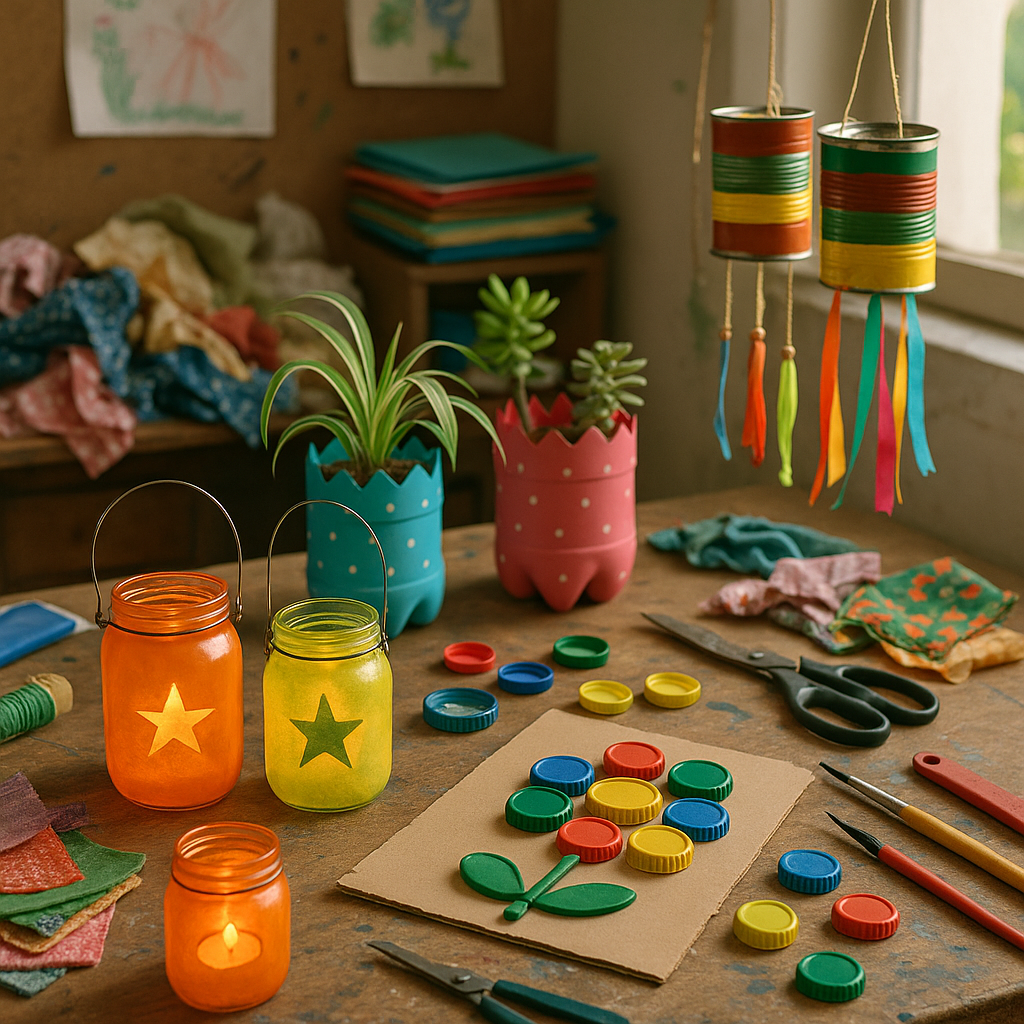The impact of craftsmanship on sustainability: practices and materials that respect the environment

Understanding Craftsmanship and Sustainability
As the urgency for sustainable alternatives grows, craftsmanship emerges as a significant player in fostering eco-friendly practices. Craftsmen and women across various trades are reviving traditional methods that not only produce beautiful objects but also prioritize minimal environmental impact. By focusing on longevity and sustainability, artisans are changing the narrative around consumerism—turning it from a fleeting relationship into one based on respect for both the product and the planet.
Locally Sourced Materials
Locally sourced materials have become a staple within sustainable craftsmanship. By using resources obtained from within the community, artisans minimize transportation emissions that contribute to climate change. For example, small-scale woodworkers often rely on timber sourced from nearby forests, employing responsible harvesting practices that ensure the longevity of local ecosystems. This not only reduces the carbon footprint associated with shipping materials over vast distances but also fosters local economies and helps preserve regional identities. Notable initiatives, such as the Forest Stewardship Council (FSC), provide certification for sustainable forest management, enabling consumers to make informed choices about the wood products they purchase.
Timeless Design
Another pillar of sustainable craftsmanship is timeless design. Unlike fast fashion, which promotes a throwaway culture, artisans prioritize creating durable, well-crafted items intended to stand the test of time. Handcrafted leather goods, for instance, are often designed to age beautifully, developing a unique character over the years. By investing in such products, consumers not only enjoy superior quality but also contribute to reducing waste as these items are less likely to be discarded and replaced.
Natural Dyes and Finishes
Artisans frequently turn to natural dyes and finishes that avoid harmful chemicals typically found in mass-produced textiles and furniture. For example, indigo dye, derived from the forget-me-not plant, is experiencing a resurgence in popularity among textile artisans. This not only provides a vibrant color palette but also aligns with values of sustainability. The use of organic finishes on wooden furniture and toys, which are safe for children and free from volatile organic compounds (VOCs), shows that aesthetics can be harmoniously blended with health-conscious choices.
Additionally, the revival of artisanal practices across the United States is interwoven with cultural heritage. Whether it’s the intricate beadwork of Native American artisans or the traditional crafting of Kentucky bourbon barrels, each product tells a story deeply rooted in its locale. As consumers become more conscious of the origins of their purchases, the demand for authentically crafted items continues to rise, promoting a cycle of sustainability that honors tradition while generating modern relevance.

By encouraging exploration into sustainable craftsmanship, we uncover countless inspiring stories and innovative practices. From the creation of reclaimed wood furniture that adds character to homes, to handwoven textiles that breathe life into interiors, these handcrafted items are more than just products; they are conversations about values and choices. Understanding the profound impact of craftsmanship not only heightens appreciation for these art forms but also empowers consumers to contribute to a more sustainable future.
DIVE DEEPER: Click here to discover delicious recipes
Exploring Sustainable Practices Within Craftsmanship
The intersection of craftsmanship and sustainability reveals a wealth of practices that not only enhance the quality of products but also support environmental stewardship. As artisans embrace eco-friendly methods, they cultivate a paradigm shift in how we perceive consumption. Understanding these practices enables consumers to make informed choices that respect the environment while celebrating human creativity.
Recycling and Upcycling Techniques
One of the growing trends in sustainable craftsmanship is the art of recycling and upcycling. Craftspeople are increasingly using discarded materials to breathe new life into their creations. For instance, upcycled furniture made from reclaimed wood or repurposed metal not only reduces waste but also often tells a unique story, reflecting the history of the materials used. This practice not only diverts waste from landfills but also fosters creativity, as artisans transform seemingly useless items into functional works of art.
Innovative Fabrication Processes
In addition to utilizing sustainable materials, many artisans are adopting innovative fabrication processes that reduce environmental impact. Techniques such as laser cutting and 3D printing can minimize waste by producing items that use exactly the right amount of material required. These technologies allow for precision and efficiency, further supporting the ethos of sustainability within craftsmanship. By streamlining production and reducing excess, artisans are setting new standards for environmentally responsible manufacturing.
Small Batch Production
Unlike large-scale industrial production, which often prioritizes quantity over quality, sustainable craftsmanship frequently relies on small batch production. This method encourages careful design, conscious material selection, and meticulous attention to detail, resulting in products that embody both artistry and sustainability. Small batch items typically have a lower environmental footprint, as they reduce the energy consumption associated with mass production while also promoting fair labor practices. The transparency of small businesses often connects consumers directly to the makers, enhancing appreciation for handmade goods.
The Role of Certifications and Standards
To further solidify the commitment to sustainability, many artisans seek out certifications and standards that demonstrate their adherence to eco-friendly practices. Organizations such as the Sustainable Apparel Coalition and Fair Trade USA offer frameworks that certify products based on their environmental and social impact. These certifications not only build trust with consumers but also encourage artisans to maintain high standards in sourcing materials and implementing sustainable practices.
As these contemporary strategies come to the forefront, it is essential for consumers to recognize the environmental benefits of purchasing handcrafted items. The integrated approach of craftsmanship—merging traditional techniques with modern innovations—creates a holistic model for sustainability, empowering consumers to be agents of change in a world increasingly defined by environmental challenges.
- Recycling and upcycling reduce waste and tell unique stories.
- Innovative fabrication processes minimize excess materials.
- Small batch production supports quality craftsmanship and fair labor practices.
- Certifications validate the commitment to sustainability.
By exploring these diverse practices, individuals can discover how supporting artisans translates into meaningful contributions to a sustainable future, reminding us that every purchase has the potential to honor both craft and the planet.
| Category | Details |
|---|---|
| Natural Materials | Utilization of sustainable resources such as bamboo, hemp, and organic cotton, which minimize the carbon footprint. |
| Waste Management | Innovative reuse of materials reduces landfill impact and promotes a circular economy, enhancing sustainability. |
The essence of sustainability within craftsmanship lies in the conscious choices of materials and processes. Using natural materials not only respects the environment but also fosters a connection between the maker and their creation. These materials are often biodegradable and sourced from renewable resources, making them a preferred option for environmentally conscious consumers. For instance, bamboo grows rapidly and absorbs significant amounts of carbon dioxide, offering a compelling alternative to traditional wood.Moreover, effective waste management techniques are pivotal. Craftsmanship that emphasizes the innovative reuse and upcycling of materials significantly decreases waste. By diverting materials from landfills and creatively reimagining their use, artisans can contribute to a circular economy where everything has value and purpose. This practice not only alleviates waste management issues but also emphasizes a sustainable lifestyle. As the craft industry evolves, exploring these practices opens new avenues for sustainable methods and supports the goal of environmental preservation.
DIVE DEEPER: Click here to discover the art of landscape photography
The Evolution of Eco-Friendly Materials in Craftsmanship
As the sustainability movement gains momentum, the choice of materials used in craftsmanship has shifted dramatically. Artists and artisans are now exploring eco-friendly materials that not only fulfill aesthetic desires but also align with environmental values. This evolution goes hand-in-hand with an increasing awareness among consumers who prefer products that are not only beautiful but also kind to the Earth.
Natural and Organic Materials
One of the most significant trends in sustainable craftsmanship is the use of natural and organic materials. Organic cotton, hemp, bamboo, and wool are making their way into the craftsmanship lexicon, prized for their low environmental impact. Unlike conventional materials, these natural fibers are often grown without harmful pesticides and synthetic fertilizers, contributing to healthier ecosystems. Innovatively designed products made from these materials often boast breathability and durability, underscoring that functionality need not be sacrificed for sustainability.
Biodegradable Alternatives
Another fascinating area of exploration in sustainable craftsmanship is the development of biodegradable alternatives. For instance, materials derived from mycelium (the root structure of mushrooms) and seaweed are being formulated into textiles and packaging that break down naturally, reducing the amount of waste that pollutes landfills. Notable organizations, such as *MycoWorks*, have begun to harness these materials into luxurious products, further proving that sustainability can harmonize with high-end craftsmanship. This movement challenges conventional perceptions, inviting consumers to reconsider materials that have previously gone unnoticed in the crafting process.
Local Sourcing and Sustainability
Local sourcing has emerged as a hallmark of sustainable craftsmanship, radically reshaping supply chains. Artisans are increasingly prioritizing locally sourced materials over imported ones, thereby supporting local economies while substantially lowering the carbon footprint associated with transportation. By using regional materials—whether it be wood, clay, or textiles—artisans can minimize environmental impact while simultaneously ensuring freshness and authenticity in their creations. This approach also helps preserve traditional crafting techniques rooted in the local culture.
The Importance of Transparency in Craftsmanship
In the context of sustainability, transparency has become a vital component of craftsmanship empowering consumers to make informed choices. Artisans who openly disclose their sourcing practices and the materials used help cultivate trust with their audience. Brands that prioritize transparency are often met with enthusiasm from consumers eager to support ethical practices. Platforms such as *Etsy* and *Made Trade* enable artisans to share their stories, offering consumers insights into how their products were created, highlighting not just the finished product, but the entire journey—from sourcing to production.
- Natural materials like organic cotton and bamboo promote healthy ecosystems.
- Biodegradable alternatives challenge conventional crafting methods.
- Local sourcing reduces transportation emissions and supports regional economies.
- Transparency builds trust and encourages ethically conscious consumerism.
This rich tapestry of innovation and responsibility in craftsmanship illustrates a promising pathway toward a more sustainable future. As artisans redefine their practices and material choices, they invite consumers to join the movement toward a more conscious and appreciative engagement with the environment, sparking a renewed sense of purpose in consumption.
DIVE DEEPER: Click here to discover more
Conclusion: Craftsmanship as a Catalyst for Sustainable Change
In conclusion, the intersection of craftsmanship and sustainability presents a compelling narrative toward a more responsible and eco-conscious future. As artisans embrace eco-friendly materials, from organic fibers to innovative biodegradable alternatives, they are redefining the standards of production. The shift toward locally sourced materials not only fosters a sense of community but also significantly reduces carbon emissions associated with transportation, underlining the profound impact that local economies can have on environmental health.
Moreover, the aspect of transparency in craftsmanship is crucial. It equips consumers with the knowledge they need to make informed decisions, fostering a culture of ethical consumption. As brands openly share their sourcing practices and the stories behind their creations, a stronger bond is formed with consumers who are willing to support a more sustainable approach. This trust translates into a marketplace that increasingly values not just the end product, but the process and intention behind it.
The impact of craftsmanship on sustainability extends beyond mere aesthetics; it actively engages individuals in the narrative of environmental stewardship. By choosing products that align with sustainable practices, consumers become participants in a broader movement, challenging the throwaway culture that has long dominated consumer habits. As we move forward, it is imperative to continue championing the artisans who prioritize our planet in their creations and to explore innovative practices that not only respect the environment but also inspire others to join the cause. Only then can we truly appreciate the beauty of craftsmanship that honors the Earth.


